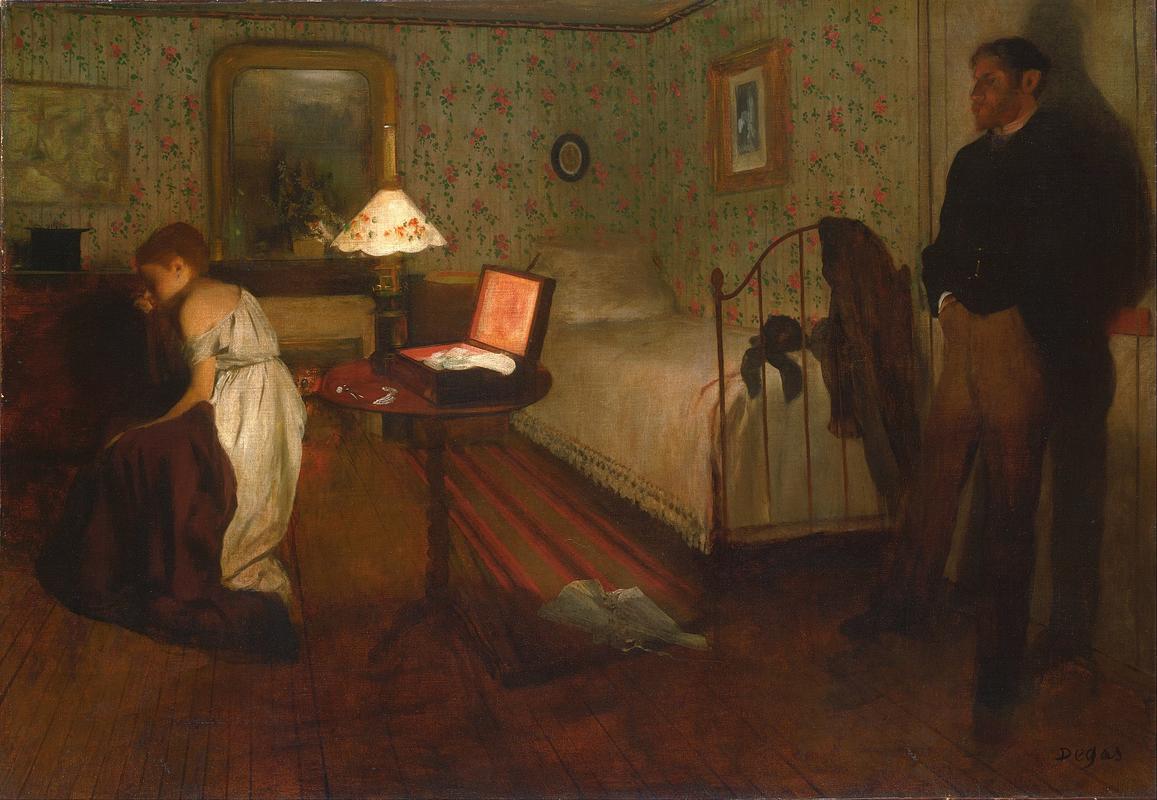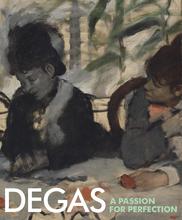More about Interior
- All
- Info
- Shop

Sr. Contributor
Before Degas discovered and subsequently became obsessed with ballerinas (he produced more than 1,500 works focusing on young ladies dancing), he needed a different outlet for his pervy ways.
The ballerina images aren’t outwardly creepy until you imagine an old guy poking around the dressing room, but Degas’s Interior definitely makes you feel uneasy when you first look at it.
He may still be remembered as part of the Impressionist group, but Degas didn’t really fit in with them, and he didn’t want to, either. Degas was a little bit of a diva and scorned the “Impressionist” title whenever it was associated with his name. This was probably because Degas was way edgier than the other Impressionists and wanted everyone to know it. Instead of the happy little trees and flowers we’ve come to associate with this particular movement, he went more for the seedy underbelly of modern life. True to Degas’ style, there is definitely no sugarcoating going on here.
The tension between the man and woman in this painting is so thick you could try to cut it with a knife and still have a hard time. Degas perfectly captures what it feels like being the third wheel with a couple that won’t stop fighting, and you’re left counting down the minutes until you can get the hell out of there. The bad vibes between the people permeate the whole painting and makes for a rather uncomfortable experience. More so, this painting leaves me full of questions. Who are these people? Where is this girl’s mom? What did this guy do to her to make her so upset, and who do I have to punch to help her out?
Because this painting is such a short glimpse of a moment between two people, it left many guessing just what Degas was trying to show. Although the work’s official title is Interior, early-twentieth-century viewers gave it the secondary title of The Rape, even though no one had any solid evidence that this was what it was showing. This mix-up is understandable considering how little Degas gives us to work with, and it does seem like something bad just happened, but the true subject of the painting remains a mystery.
One theory lies in the alternate title The Rape, which suggests a sordid situation between this man and a girl who looks way too young to be there alone with him (and we know Degas was definitely into younger women). Another theory is that Degas was painting a scene from a novel by Émile Zola, a writer who was bros with many of the artists of the time. The scene comes from Thérèse Raquin and shows Thérèse and her now-husband Laurent having an awkward time on their wedding night because they realized that the only reason they can now be together is because they killed Thérèse’s first husband. Think Bonnie and Clyde, but more broody and way less fun. Even though both arguments are convincing, Degas’ deliberate ambiguity allows people to read the scene in their own way. So maybe I’m the perv for assuming that something weird either just went down or is about to go down between these two people? Thanks, Degas.
Sources
- Finocchio, Ross. “Nineteenth-Century French Realism.” The Heilbrunn Timeline of Art History. The Metropolitan Museum of Art. October 2004. http://www.metmuseum.org/toah/hd/rlsm/hd_rlsm.htm
- Schenkel, Ruth. “Edgar Degas (1834-1917): Painting and Drawing.” The Heilbrunn Timeline of Art History. The Metropolitan Museum of Art. October 2004. http://www.metmuseum.org/toah/hd/dgsp/hd_dgsp.htm.
- The Philadelphia Museum of Art. Interior. 2017. http://www.philamuseum.org/collections/permanent/82556.html
- Tate. “Degas, Sickert and Toulouse-Loutrec: Room 8.” 2017. http://www.tate.org.uk/whats-on/tate-britain/exhibition/degas-sickert-a…
- Weinberg, Barbara H., Doreen Bolger, and David Park Curry. American Impressionism and Realism: The Painting of Modern Life, 1885-1915. New York: The Metropolitan Museum of Art, 1994.
Featured Content
Here is what Wikipedia says about Interior (Degas)
Interior (French: Intérieur), also known as The Rape (French: Le Viol), is an oil painting on canvas by Edgar Degas (1834–1917), painted in 1868–1869. Described as "the most puzzling of Degas's major works", it depicts a tense confrontation by lamplight between a man and a partially undressed woman. The theatrical character of the scene has led art historians to seek a literary source for the composition, but none of the sources proposed has met with universal acceptance. Even the painting's title is uncertain; acquaintances of the artist referred to it either as Le Viol or Intérieur, and it was under the latter title that Degas exhibited it for the first time in 1905. The painting is housed in the Philadelphia Museum of Art.
Check out the full Wikipedia article about Interior (Degas)













